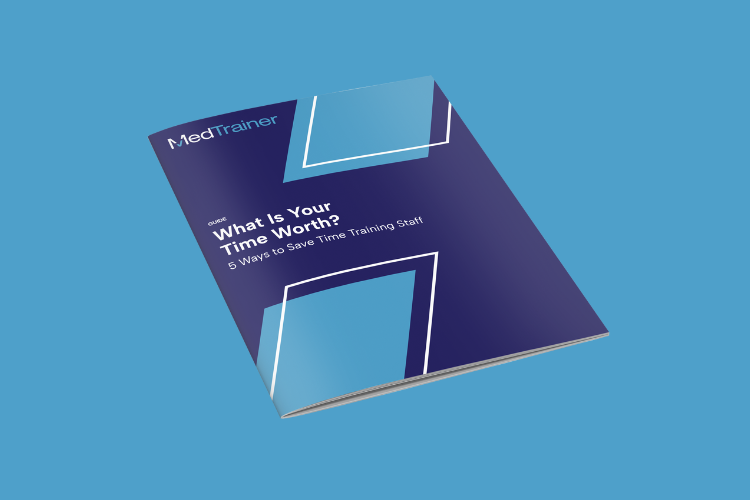Almost every healthcare group we talk with mentions staffing as an area of concern. With so many people moving, switching careers, or generally ready for a change, turnover is higher than ever for many in the healthcare industry.
Healthcare administrators are in a tough spot because they wear many different hats and are pulled in many different directions. Add in high staff turnover and your tasks multiply with hiring, onboarding, and credentialing.
In a 2023 MedTrainer poll, 47% of respondents said the person handling credentialing also has other responsibilities.
Luckily, there are some tricks to make the most of a tough situation and still thrive amidst staff shortages.
Watch this on-demand webinar to see how MedTrainer helps with staffing shortages.
6 Tips to Lessen the Pain of Healthcare Staffing Shortages
1. Make Documents and Policies Accessible to All Staff
When you’re short-staffed, you don’t have time for employees to be walking from office to office, escalating incident reports and worrying about safety data sheet management. You need a quick resolution so they can move on to the next task.
Storing all important documents and policies in a single compliance platform makes it easy for staff to find what they need, when they need it. Whether it’s a safety plan, company policy, SDS, or incident report, it can all be accessed in one spot by using technology.
2. Bring Your Training Online
One of the most obvious tasks to start moving off your plate is your staff training. Training usually falls to the office administrator, but let’s face it — with staffing shortages, an administrator just doesn’t have time to find relevant courses, schedule in-person sessions, send reminders, and track completion.
And you don’t want a medical assistant or front desk staff doing training. It’s not what they’re best at, and it takes time away from their core responsibilities. Plus, training is important and needs to be done right.
Using a learning management system (LMS) removes the manual work and barriers to healthcare training. With MedTrainer’s healthcare training software, you have nearly 1,000 courses to choose from, including hundreds of continuing education options. You’re able to automate many of the manual tasks associated with training and your staff can complete the courses from anywhere in the cloud-based platform.

Calculate how much a manual training process is costing your organization.
3. Improve Your Onboarding
Your onboarding process is almost like your practice’s first date with a new hire. The process should be smooth, transparent, and helpful to make a good impression and ensure your new staff member wants to stay.
Download a healthcare onboarding checklist.
Your onboarding process may include some or all of these:
- Organization-specific training, which is especially important for front desk staff because they make the first impression on patients!
- Completion of orientation checklists
- OSHA training (required to be done within the employee’s first 10 days)
- Gathering documents to credential new providers
- Documents and policies that new hires need to review and sign
Gathering needed documents from new providers is one of the most time-consuming steps, but doing it right can help with staff retention, get providers in front of patients faster, and ensure payer enrollments are complete.
The reality is it can be difficult to make sure every new hire completes all these tasks, and it can be nearly impossible to also make the process engaging and helpful for the new staff member or provider.
This is where technology comes in.
MedTrainer’s cloud-based platform simplifies the onboarding and credentialing process. Once your new hire is entered into the system (or recognized through one of our integrations), they’re assigned courses to complete, documents to review and sign, and asked to upload any needed information. Reminder emails are automated within the system, taking this dreaded task off your plate. Plus, with robust reporting capabilities, you always have access to real-time data on progress, completions, and outstanding items.
Once you start using the system, you’ll never want to go back. Automation means it’s hands-off for you, and staff members complete the process faster.
4. Automate Manual Tasks
Start automating tasks as much as possible. If you’re spending half of your day chasing down people for documents or signatures or reminders about training, this is for you.
We know from experience that while chasing after people might increase your step count, it’s not great for getting home at a reasonable time.
Think outside the box with automation.
MedTrainer automates the distribution of documents and policies, requests for electronic signatures, and reminders. Build a group of policies based on role, department, or location and send them for review and acknowledgement with just a few clicks. Reminders are automated, so you don’t have to feel like you’re nagging. For providers who need to recredential, reminders are sent starting at 180 days before expiration. Training and policy acknowledgment reminders start at 30 days from the due date and then are sent weekly once past due.
5. Standardize Processes by Role, Department, or Location
When you have multiple locations, the goal is typically to have everyone working in the same optimized way. Of course, this is easier said than done.
To make the dream a reality, it’s important to be able to train consistently and distribute the same policies across all of your locations. Then you need to track and measure completed training, who has reviewed policies, and how each location is staffed.
But who has the time or personnel to do all that?!
Working with hundreds of healthcare organizations, MedTrainer’s experts have developed methodologies and processes that work. Use reports to understand if one location — or department — is taking longer to credential, experiencing more incidents, or not completing training. Perhaps one group has high turnover or a supply chain issue, which is causing more incidents. Seeing the data all together in a unified platform can identify these trends so you can quickly fix them.
6. Let Technology Pick Up the Slack
We’re in a high-turnover environment now, with people switching jobs and even transitioning to new careers. While it’s a little scary to think about, your in-house credentialing expert, or another essential admin, could leave.
If that person’s work is all on paper, or in an Excel spreadsheet, it’s going to be very difficult for you or someone else to pick up where they left off. Yikes.
A unified platform, such as MedTrainer, can help prevent stress when a staff member quits and enable your organization to continue work from anywhere. Staff and practitioners can complete tasks even when they’re working remotely. Using technology to manage all of your compliance and administrative work ensures policies and procedures, disaster preparedness plans, SDSs, or whatever else you need, are always available under any circumstance.
What to Look for in a Compliance Tech Solution?
There are a couple of factors that make the best technology solutions stand out from the rest. Cut ties with technology that’s just not working, and seek new options that truly make a difference.
Unified Platform
The biggest thing to look for is a unified platform. No one wants to be jumping between 15 different technologies to do the job. That ends up taking almost as much time as doing it all manually. So, look for the most comprehensive platform you can find to reduce friction and stress.
Expertise
It’s also good to have a tech solution that comes with healthcare experts and excellent customer support. Sometimes (ok, a lot of the time!) it helps to have a consultant for tough questions, especially when talking about compliance or credentialing.
Processes can be very specific to your state or payer, so it’s crucial to deal with a company that has the support in place to assist you individually with these complicated issues.
Time-Savings
As you evaluate healthcare technology, keep in mind the tasks that are taking you the longest and ensure the new platform will cut down that time. If you have a great credentialing process, then you might not need the bells and whistles that some technology offers. But, if your whole day is spent onboarding new hires, then you want to be sure the tech you choose will streamline that process.
Use MedTrainer to Help with Healthcare Staffing Shortages
MedTrainer is the only unified healthcare compliance software, so it’s a natural fit for a wide variety of healthcare organizations. You can use the whole platform, or choose individual tools based on your specific needs and budget.
Watch this on-demand webinar to see how MedTrainer helps with staffing shortages.
Or reach out and one of our experts can guide you through your unique challenges and formulate a package to give you the most value for your budget. Click here to start the conversation.
 Learning
Learning